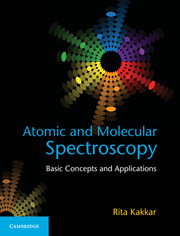Book contents
- Frontmatter
- Dedication
- Contents
- List of Figures
- List of Tables
- Preface
- Acknowledgements
- List of Abbreviations
- 1 Fundamentals of Spectroscopy
- 2 Theoretical Principles
- 3 Atomic Spectroscopy
- 4 Pure Rotational Spectroscopy
- 5 Vibrational Spectroscopy of Diatomics
- 6 Vibrational Spectroscopy of Polyatomic Molecules
- 7 The Raman Effect
- 8 Electronic Spectroscopy of Diatomic Molecules
- 9 Electronic Spectroscopy of Polyatomic Molecules
- Appendix 1 THE SPECTRUM OF THE NON-RIGID ROTATOR
- Appendix 2 CHARACTER TABLES OF SOME IMPORTANT SYMMETRY GROUPS
- References
- Index
Preface
Published online by Cambridge University Press: 05 June 2015
- Frontmatter
- Dedication
- Contents
- List of Figures
- List of Tables
- Preface
- Acknowledgements
- List of Abbreviations
- 1 Fundamentals of Spectroscopy
- 2 Theoretical Principles
- 3 Atomic Spectroscopy
- 4 Pure Rotational Spectroscopy
- 5 Vibrational Spectroscopy of Diatomics
- 6 Vibrational Spectroscopy of Polyatomic Molecules
- 7 The Raman Effect
- 8 Electronic Spectroscopy of Diatomic Molecules
- 9 Electronic Spectroscopy of Polyatomic Molecules
- Appendix 1 THE SPECTRUM OF THE NON-RIGID ROTATOR
- Appendix 2 CHARACTER TABLES OF SOME IMPORTANT SYMMETRY GROUPS
- References
- Index
Summary
This book is primarily intended for post-graduate students of science, but is simple enough for an undergraduate student to understand. Every chapter begins with simple concepts related to the topic of the chapter, and gradually Quantum Mechanical and Group Theoretical treatments are introduced for a deeper understanding. I have tried to keep the language simple and have introduced new concepts one at a time, so that the reader is not overwhelmed by too many new ideas at the same time.
Spectroscopy is so vast and new concepts are rapidly emerging, so that it is not possible for a book to be complete. This book does not pretend to be complete—but it does try to cover the underlying principles thoroughly so that the reader should not face difficulty in applying these principles to his own problem.
Spectroscopy cannot be understood without a thorough knowledge and understanding of quantum mechanics. Though a number of Quantum Mechanics principles are scattered throughout the book, the reader is advised to first take at least an elementary course on quantum mechanics. The reader must also familiarize himself/herself with Group Theory—at least to the extent of assignment of molecular point groups, calculation of direct products, projection operator techniques, etc. There are a number of excellent texts, namely Cotton, Schonland, Ladd, to name a few. Again, a brief description of these techniques is given as and when required. Though I was advised by a reviewer of the book to include a chapter on Group Theory, it would have added to the volume and cost of the book, because there is nothing I could have removed from the other chapters in order to keep the page number around 400.
One other point—all chapters are arranged in sequence, so that a concept introduced in a certain chapter is used in one of the next chapters—so you cannot expect to understand, say the third chapter, without first reading the first two chapters.
- Type
- Chapter
- Information
- Atomic and Molecular SpectroscopyBasic Concepts and Applications, pp. xvii - xviiiPublisher: Cambridge University PressPrint publication year: 2015

